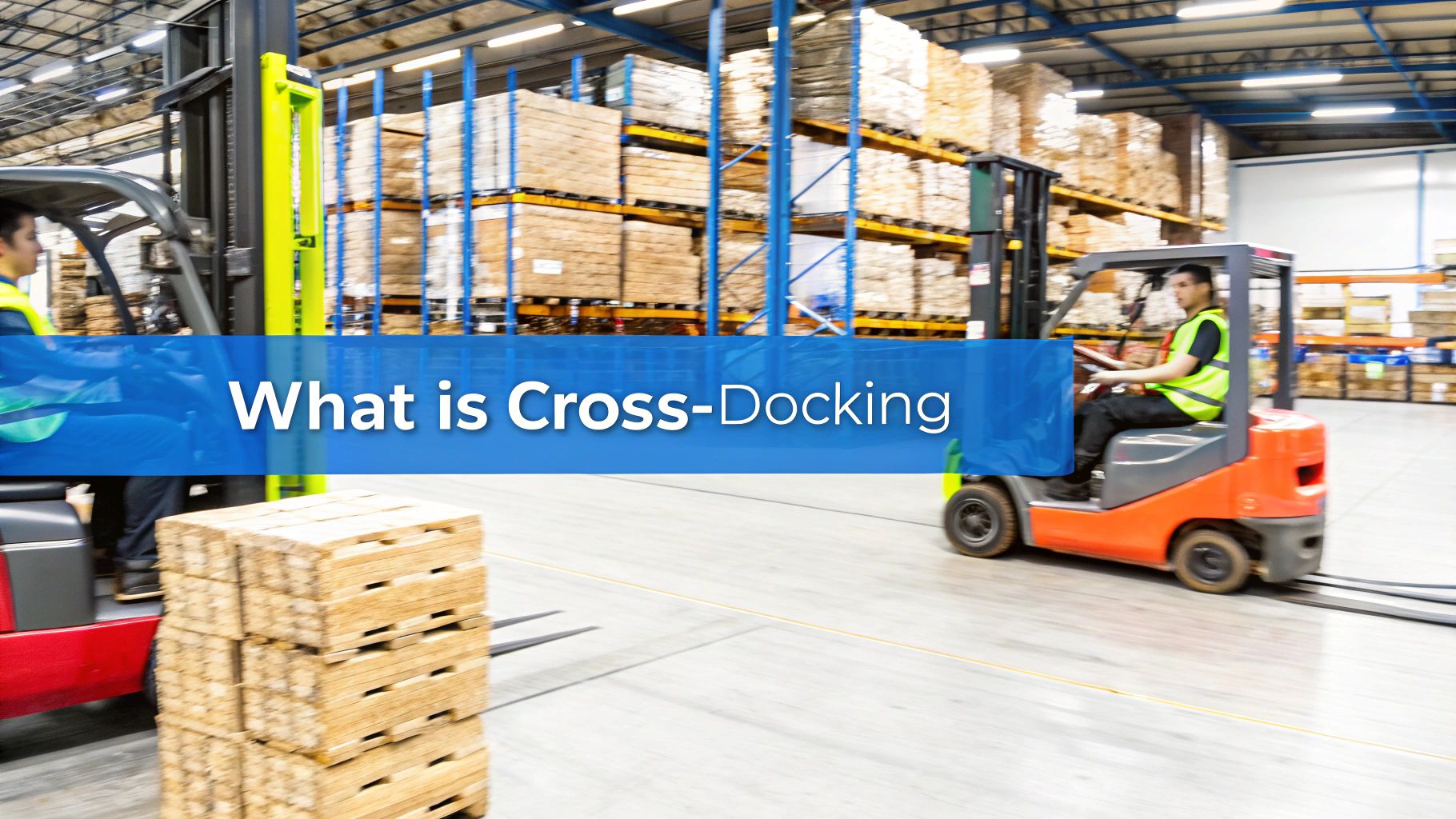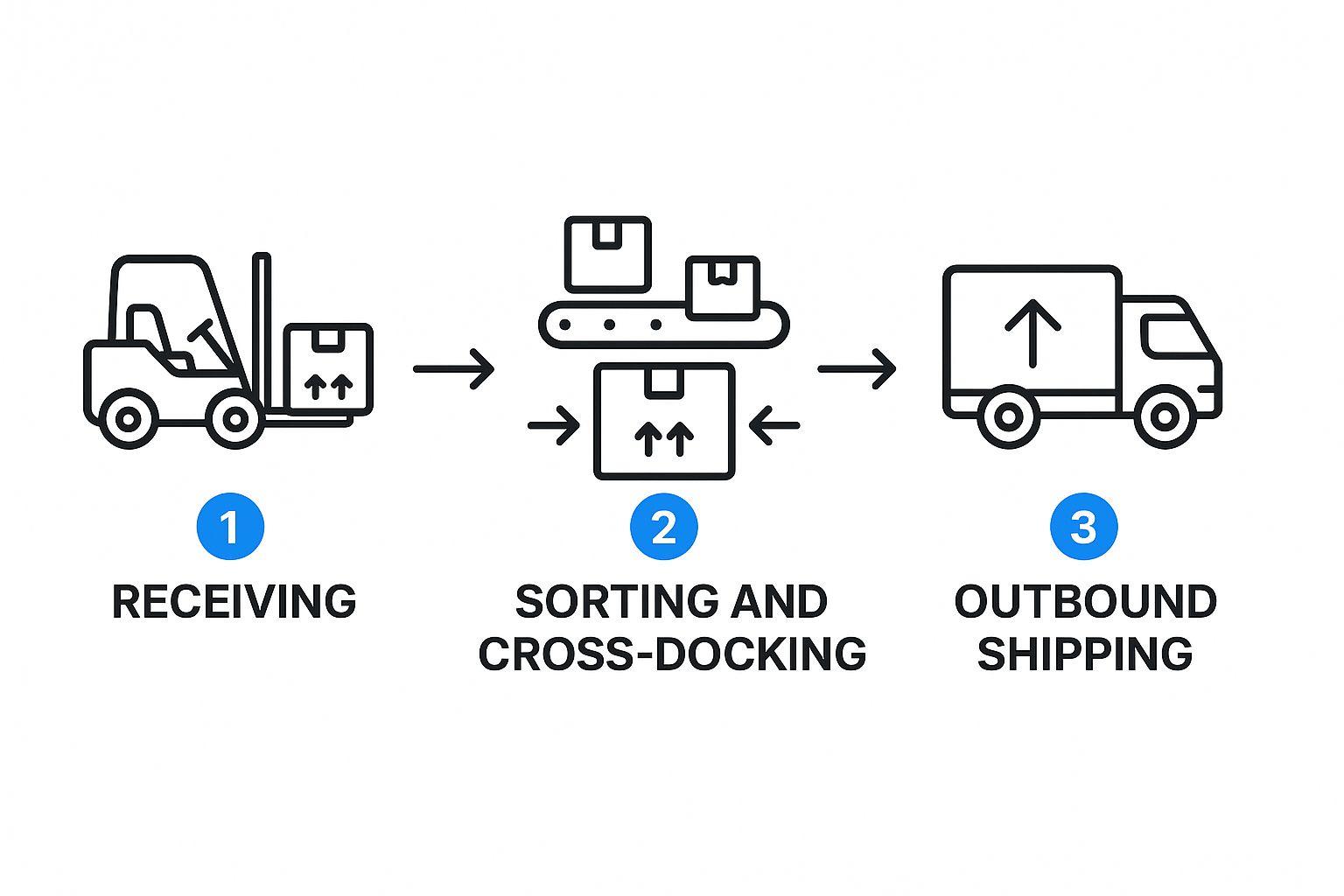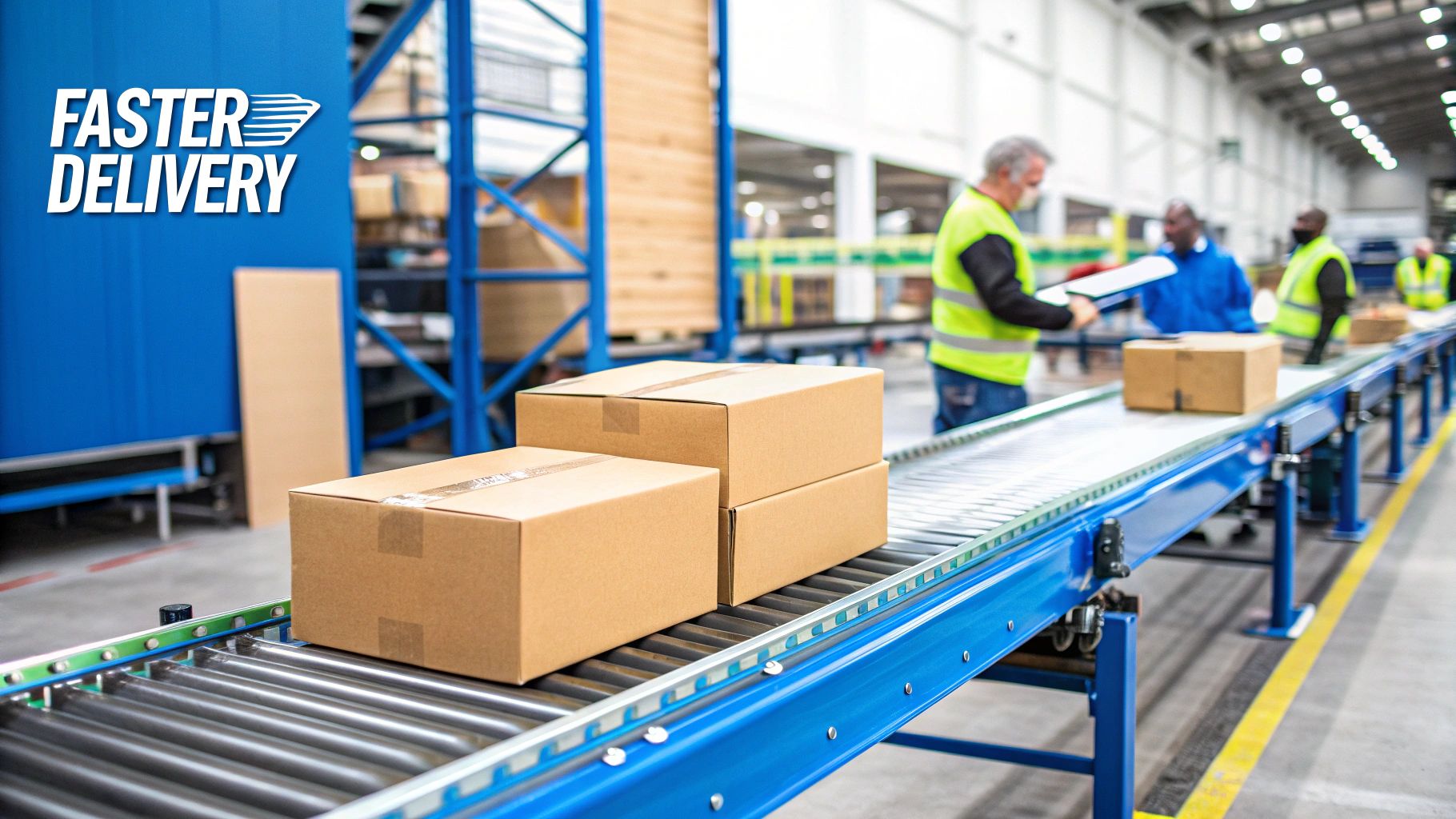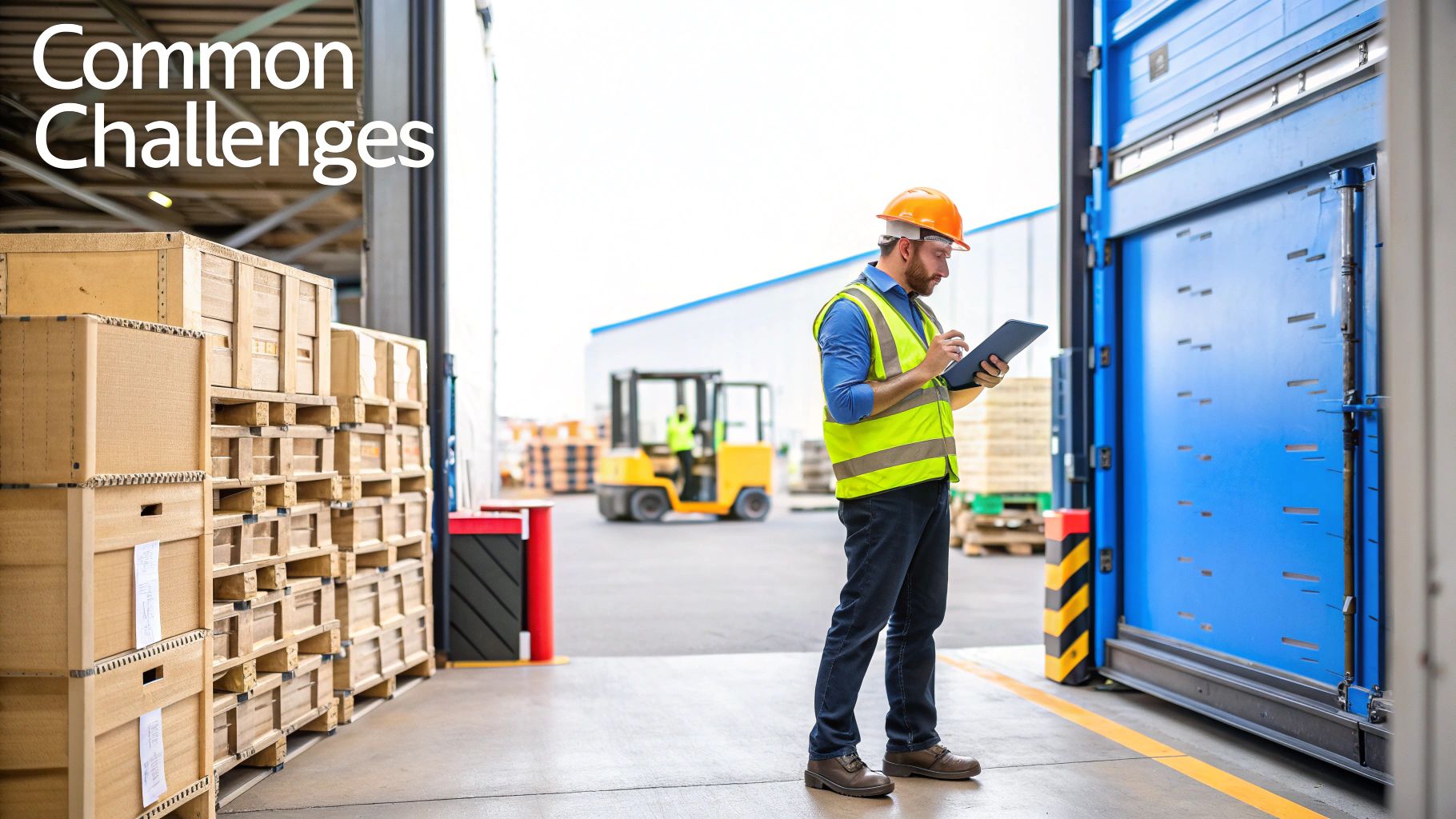Cross docking is a logistics strategy where products from a supplier or manufacturing plant are distributed directly to a customer or retail chain with minimal to no handling or storage time. Think of it as an airport hub for packages instead of people—goods arrive, are sorted immediately, and leave on outbound trucks, often within a few hours.

At its core, cross docking is all about velocity. It’s a supply chain method designed to get products from point A to point B as fast as possible by completely removing the middle step: long-term warehouse storage.
Instead of receiving goods, putting them on shelves for days or weeks, and then picking them for an order, this approach keeps everything in constant motion. It fundamentally changes the purpose of a distribution center, transforming it from a static storage facility into a dynamic sorting hub.
Products arrive on inbound trucks, are swiftly unloaded, sorted, and loaded directly onto outbound trucks destined for their next location, whether it's a retail store or the end customer.
The real magic of cross docking lies in its philosophy. Traditional warehousing operates on a "just-in-case" model, holding onto inventory to buffer against unexpected demand. Cross docking, on the other hand, thrives on a "just-in-time" principle.
This focus on continuous movement is why it's so effective. In 2024, companies that implemented cross docking saw up to a 25% reduction in order fulfillment time—a massive advantage in today’s fast-paced market. That speed doesn't just shorten delivery windows; it also significantly lowers operational costs. For a deeper look into the components of getting orders out the door, check out our guide on what is eCommerce fulfillment.
The ultimate goal of cross docking is to touch a product only once. The less a product is handled, stored, and moved, the lower the risk of damage, the less labor is required, and the faster it reaches its final destination.
To really get a feel for how different these two approaches are, it helps to put them side-by-side. Each serves a distinct purpose, and this comparison makes it clear where cross docking truly shines.
So, what is cross docking in the end? It's a strategic choice to prioritize speed over storage, creating a lean, responsive, and incredibly efficient supply chain.
To really get what cross docking is all about, let's follow a single shipment on its lightning-fast journey through a cross docking terminal. Forget everything you know about traditional warehousing. This is more like a carefully choreographed dance where timing, technology, and precision are everything.
The entire operation is built around one simple idea: the "touch it once" principle. The goal is to slash handling time and crank up the velocity from the moment goods arrive until they leave.
It all starts long before a truck even pulls up to the dock. The magic begins with meticulous planning. Logistics coordinators, using a Transportation Management System (TMS), schedule inbound deliveries to arrive in a perfect sequence. This prevents traffic jams at the docks and ensures outbound trucks are already in position, ready to go. This pre-planning is the secret sauce to a smooth cross docking operation.
As an inbound truck backs into its assigned dock door, the clock starts ticking. The receiving team doesn't just unload pallets; they kick off a rapid-fire identification process. The moment a pallet or carton comes off the truck, they zap it with a handheld scanner, reading its barcode or RFID tag.
That single scan is a game-changer. It instantly feeds data into the Warehouse Management System (WMS), confirming the product’s arrival and giving it a final destination—a specific outbound dock door for immediate departure. This step is make-or-break; any hesitation here creates a bottleneck that can throw the whole system out of whack. To see just how critical this first stage is, check out our deep dive into the modern warehouse receiving process.
The infographic below really brings this high-speed, three-stage flow to life.

As you can see, products are in constant motion. They move seamlessly from receiving to sorting and straight to shipping, never once stopping to be put away in storage.
Once off the truck, the goods hit the central staging area. This is the heart of the whole operation—an open, fluid space designed purely for movement, not storage. Here, products are sorted and grouped based on their final destination.
This sorting happens in one of two main ways:
This sorting is often a blur of activity, helped along by automated conveyor systems and guided by the WMS, which tells workers exactly where each item needs to go. The goal here is to get this done in minutes, not hours.
With goods sorted and ready, the final step is getting them onto the outbound trucks. Workers use forklifts or pallet jacks to hustle the newly built pallets to their assigned dock doors, where another team is waiting to load them.
The whole system's success hinges on this last stage. The outbound truck needs to be ready to pull away almost as soon as the last pallet is on board, making sure the product's journey continues without a single wasted moment. From arrival to departure, the entire workflow is a masterclass in efficiency, turning what could be a storage headache into a massive strategic advantage.

Once you grasp the basic idea of cross docking, you'll see it's not a one-size-fits-all solution. It's more like a flexible logistics playbook with several specialized strategies, each designed to solve a very specific supply chain puzzle. Picking the right one is crucial for getting the most out of it, as each type is built for a different operational game plan.
This adaptability is exactly why it's catching on. The global market for cross docking services hit about USD 241.7 billion in 2024 and is projected to reach USD 307.8 billion by 2030. That kind of growth shows just how many businesses are turning to specialized logistics to get a competitive edge.
Let's break down the most common types to see how they work in the real world and figure out which one might be the right fit for your business.
Think of manufacturing cross docking as the heartbeat of a just-in-time production line. In this setup, the cross docking facility is the central hub where inbound materials and parts from different suppliers arrive. These items are immediately sorted and shuttled directly to the manufacturing plant.
Instead of piling up parts in a warehouse, this system feeds the assembly line exactly what it needs, right when it's needed. This move drastically cuts down on the need for on-site inventory, which frees up valuable factory floor space and slashes the costs of holding onto raw materials.
Example: An automotive plant gets engines from one supplier and transmissions from another at its cross docking terminal. These major components never sit on a shelf; they’re immediately consolidated and sent to the assembly line to be installed in cars being built that very day.
This is your classic consolidation play. Distributor cross docking is all about gathering products from multiple suppliers and combining them into a single, mixed pallet or one full truckload bound for a common customer, usually a retailer.
It's a game of efficiency in numbers. Instead of ten different suppliers sending ten half-empty trucks to a single retail DC, they all ship their goods to a cross docking facility. There, the products are sorted and loaded onto one full, cost-effective shipment, making the receiving process a breeze for the final destination.
This method turns a logistical headache into a well-organized flow. It centralizes the sorting process, making it far easier for retailers to manage incoming inventory from a wide array of vendors.
For businesses adopting this model, the physical facility is everything. Looking at a guide to warehouse steel buildings can be a huge help when planning the right kind of space for these fast-paced operations.
Transportation cross docking is laser-focused on one thing: making the transport network itself more efficient. This type of cross docking combines shipments from different carriers to build full truckloads, which cuts costs and makes better use of every truck on the road.
You can think of it as the logistics world's version of a carpool. It’s especially common in less-than-truckload (LTL) shipping. Smaller shipments are brought to a central hub, combined into a more economical full truckload (FTL), and sent off on the long-haul part of their journey. This keeps shipping costs down for everyone and means fewer trucks on the highway.
Retail cross docking is all about speed-to-shelf. This process is set up to handle goods that arrive from the supplier already pre-tagged and sorted for specific retail stores. When a shipment hits the cross docking facility, it's a simple move from the inbound truck to the correct outbound truck heading to its designated store.
This model is a go-to for fast-fashion brands and grocery chains that need to move perishable goods quickly. By the time the products arrive at the store, they are ready to go directly on the shelves, cutting down on backroom labor and getting them in front of customers almost immediately.
These different flavors of cross docking show how the practice transforms a facility from a static storage space into a dynamic sorting center—a key difference we explore in our breakdown of a fulfillment center vs distribution center.
Beyond the operational "how-to," the real question for any business is always "why?" What tangible results can you actually expect from rethinking your logistics to bring in cross docking? This strategy isn't just about shuffling boxes around faster; it's a direct path to a leaner, more profitable, and more competitive supply chain.
The business case for cross docking is built on a foundation of radical efficiency. By completely cutting out entire steps from the traditional fulfillment playbook—namely, putting items away and long-term storage—companies unlock immediate and significant cost savings. Every single pallet that avoids sitting on a warehouse shelf represents a direct hit to your expense column.
The most immediate and obvious benefit comes from slashing labor and storage expenses. Traditional warehouses are hungry for manpower, requiring teams for receiving, stowing, picking, and packing. Cross docking condenses these roles, leading to a major reduction in the hours needed to process the same amount of goods.
Fewer touches mean fewer labor hours. It also means a lower risk of handling errors or damage. Since products don't stick around, the need for vast storage space with endless racking systems shrinks dramatically. This doesn't just cut down on real estate costs; it also trims the fat from associated expenses like utilities, insurance, and security for a massive storage facility.
By minimizing the time inventory spends sitting idle, cross docking directly attacks one of the biggest hidden expenses in any supply chain. It transforms the cost center of a storage warehouse into a high-velocity, value-adding sorting hub.
In today's market, speed is currency. Fast shipping isn't a perk anymore; it's a core customer expectation. Cross docking shortens the order-to-delivery cycle in a big way, often shaving entire days off the timeline. This accelerated fulfillment translates directly into happier, more loyal customers.
Picture a retailer launching a hot new promotional item. With cross docking, that product can move from the supplier to store shelves in under 24 hours, hitting the sales floor while consumer hype is at its absolute peak. This kind of responsiveness gives businesses a powerful competitive advantage, letting them react instantly to market trends and demand spikes.
And this speed doesn't just please customers—it strengthens your B2B relationships, too. Retailers and distributors love suppliers who can deliver products quickly and reliably. That can lead to stronger partnerships and even better shelf placement for your products.
Holding onto inventory is both risky and expensive. Products sitting in a warehouse are vulnerable to damage, theft, and becoming obsolete—especially items with a short shelf life like fresh food, electronics, or seasonal apparel. Cross docking sidesteps these risks by keeping inventory in constant motion.
By reducing the amount of stock you have on hand, you can seriously lower your inventory holding costs. These expenses aren't just about storage; they include the capital you have tied up in unsold goods. You can learn more about how to calculate inventory holding costs to see just how big these savings can be.
To fully appreciate how cross-docking contributes to cost savings and increased throughput, it's beneficial to compare it with other effective inventory management practices that businesses utilize. Ultimately, less stored inventory means:
When you look at it all together, the business case is crystal clear. Cross docking delivers a trifecta of benefits: lower operational costs, faster delivery speeds, and reduced inventory risk, creating a more agile and financially sound supply chain.

While the benefits sound amazing, it's crucial to understand that cross docking isn't a silver bullet for every supply chain. This is a highly specialized strategy, and forcing it onto a business with the wrong products or unpredictable demand can backfire spectacularly, creating more chaos than efficiency.
The real key is knowing where it shines and where traditional warehousing still reigns supreme. Cross docking is a perfect fit for companies with high-volume, predictable product flows that don't need much handling. It’s a strategic choice that has to align with your operational reality.
So, how do you know if it's right for you? It starts with a clear-eyed look at your products, your customers, and your supply chain's overall maturity.
Some products and business models are practically tailor-made for the cross docking environment. If your operation deals with any of the following, you're likely a prime candidate to benefit from this high-velocity logistics model.
These businesses usually share a few common traits: stable demand, pre-packaged goods, and an urgent need for rapid inventory turnover.
On the other hand, some scenarios make cross docking completely impractical. If your business depends on flexibility, value-added services, or managing unpredictable inventory, a traditional warehouse is still your best bet.
Trying to cross dock products that aren't suited for it just creates bottlenecks and defeats the entire purpose of the strategy. You have to recognize when holding inventory is a strategic asset, not just an operational cost.
Cross docking thrives on predictability and precision. When demand is erratic or products require significant hands-on work before shipment, the "store and manage" approach of a warehouse provides the necessary buffer and control.
Here’s when sticking with a traditional warehouse makes more sense:
Still on the fence? This table breaks down the core characteristics that make a business a great fit for cross docking versus one that would be better served by a traditional warehousing model.
Ultimately, the choice comes down to your unique operational DNA. A business built on speed and predictability can unlock massive savings, while one needing flexibility and control will find more value in a classic warehouse setup.
The growth of cross docking is especially strong in developed markets. For instance, North America is a leader here, expected to hold about 41.7% of the global market share in 2025, driven by its huge retail sector and advanced logistics networks. You can learn more about the cross docking services market and its regional breakdown to see how this trend is playing out globally. This maturity shows how established supply chains can really squeeze every bit of efficiency out of the model.
As we've unpacked the what, how, and why of cross docking, a few practical questions always seem to pop up. This strategy is powerful, no doubt, but it also represents a pretty big shift in how you run your operations. To clear up any last-minute uncertainties, let's tackle the most common questions that come up when businesses think about making the switch.
Think of this as a final consult, where we get straight to the point on the real-world hurdles you might face with technology, business size, and implementation.
Let's be blunt: trying to run an effective cross docking operation without the right tech is nearly impossible. The whole system relies on speed and precision, which means you need real-time information and flawless communication across your entire supply chain.
The absolute cornerstone is a robust Warehouse Management System (WMS). This software is the brain of the operation, giving you total visibility of your goods from the moment they arrive to the second they leave. It has to work hand-in-glove with tools like barcode or RFID scanners for instant product identification and sorting.
But a WMS doesn't work in a vacuum. A few other players are just as critical:
Without this integrated tech stack, you’d be trying to direct a symphony with a blindfold on. It would be slow, chaotic, and full of costly errors. The technology isn't just a nice-to-have; it's the engine that makes the whole thing go.
This is one of the biggest myths out there. While giants like Walmart are the textbook examples, small and medium-sized businesses (SMBs) can absolutely get in on the action. The secret isn't about your company's size; it's about your strategy and who you partner with.
For most SMBs, the golden ticket is a third-party logistics (3PL) provider. Working with a 3PL gives a smaller company instant access to established cross docking facilities, cutting-edge technology, and logistics expertise—all without the massive upfront cost of building a terminal or buying a six-figure software suite.
Partnering with a 3PL basically democratizes cross docking. It lets smaller brands tap into the same supply chain efficiencies that huge corporations use for their competitive edge. It’s a scalable growth strategy, not an exclusive club for the big guys.
Here are a few ways an SMB could leverage a 3PL's cross docking services:
Success hinges on predictable demand and reliable suppliers, not your annual revenue. With the right 3PL in your corner, cross docking becomes an incredibly powerful and accessible tool for any business ready to scale.
Jumping into cross docking is a major operational commitment, and the challenges all revolve around three things: precision, coordination, and trust. If you get it wrong, you can create a bigger mess than the one you were trying to solve. It’s crucial to go in with your eyes wide open.
The first and biggest hurdle is supplier synchronization. The whole model is built on inbound trucks arriving within tight, pre-scheduled time windows. A single late truck can create a domino effect, clogging up the docks, delaying outbound shipments, and throwing the entire day's plan into chaos. This demands an incredibly high level of communication and reliability from every partner in your supply chain.
Second, there is zero room for error. Because goods aren't being stored, there’s no buffer to catch mistakes. A mislabeled pallet sorted to the wrong outbound dock could end up hundreds of miles away in the wrong state. That means expensive returns, frustrated customers, and a logistical nightmare to fix. Perfect accuracy in labeling and scanning isn't just a goal; it's a requirement.
Finally, there’s the initial investment. Even if you're not building a new terminal from scratch, adapting a warehouse for cross docking requires a specific layout—plenty of dock doors and a wide-open central staging area. It also requires investing in the right forklifts, conveyor systems, and the integrated WMS and TMS tech needed to run a smooth operation. It’s a serious commitment of capital, planning, and deep trust in your partners.
Ready to unlock the speed and efficiency of cross docking without the massive upfront investment? At Simpl Fulfillment, we provide the advanced 3PL infrastructure and expertise to make it happen. We help you streamline your supply chain, reduce costs, and get your products to their destination faster. Learn how Simpl Fulfillment can power your growth today!